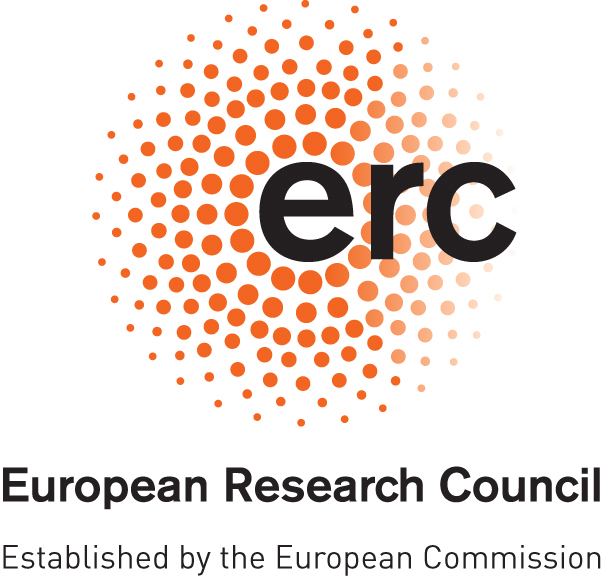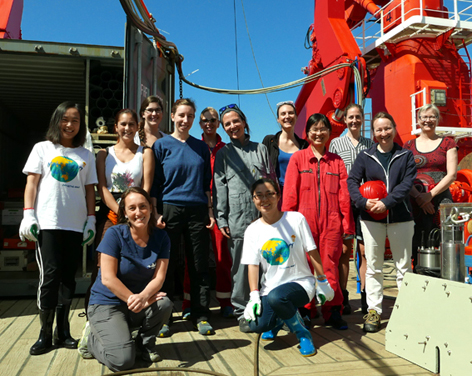- Press Office
- Blogs and More
- International Women´s Day at sea - Blogpost 3 from RV SONNE, March 8, 2018
International Women´s Day at sea - Blogpost 3 from RV SONNE, March 8, 2018
On Board RV SONNE, Chile
24 ° 17.097 S, 71 ° 25,44 W
Thursday, March 8, 2018
In the meantime, we have left sampling site 1 on the bathyal plain and moved on to sampling site 6 at the Atacama trench. Everybody is in a good mood, we are on schedule. Thanks to the experienced crew of the RV Sonne we have collected many samples and data from the deep seafloor close to 8000 meters depth.
Today, while I am writing this blogpost, it is International Women’s Day. Taking a look around, our scientific crew on board RV Sonne is quite international and some of our scientists are women. Taking a look back into the past of marine science, most of the crew on board ships had been male. Since these days have passed the gender ratio has changed a lot but still women are underrepresented on board research vessels. The situation in academia seems different at first glance. Looking at the universities, in bachelor, master and PhD programs more than 50% of the students in science are female, but in higher scientific positions a considerably lower percentage of women are represented.
On the occasion of today´s International Women’s Day, we would like to introduce our female scientific crew. These women represent 13 out of 40 scientists on expedition SO261.
- Anni Glud from Odense, University of Southern Denmark, is working on sensor technology and has already participated in many cruises.
- Blandine Trouche is a PhD student from the French University in Brest. She is interested in extracellular DNA of archaeal and bacterial origin.
- Daniela Zeppilli is a researcher from Italy. She is a specialist on deep-sea meiofauna at the IFREMER in Brest, France.
- Heather Stewart is a marine geologist from the British Geological Survey in UK interested in geomorphology.
- Laura Hehemann from Canada works for the Alfred-Wegener-Institut Helmholtz-Zentrum für Polar und Meeresforschung (AWI) in Bremerhaven, Germany. She is creating high-resolution sonar maps of the seafloor for the scientists on board.
- Lorena Arias from the Universidad de Concepcion in Chile is a technician working in carbon geochemistry.
- Mackenzie Gerringer, a PostDoc from University of Washington, USA, is studying deep-sea megafauna.
- Miriam Brandt, a PhD student from Germany works on eukaryotic DNA from deep-sea microorganisms for IFREMER, France.
- Pei-Chuan Chuang from Taiwan, a PostDoc at MARUM – Centre for Marine Environmental Sciences of the University of Bremen, Germany, is studying the pore water profiles of sediment cores from the deep sea to mathematically model the underlying processes.
- Sophie Arnaud Haound is a group leader at MARBEC at IFREMER in Sete, France. She is working on environmental DNA from the deep sea.
- XinXin Li is assistant professor of the TAGOR group at the Southern University of Science and Technology in China (TAGOR= The Archaeal Geo-Omics Research). She is working in organic biogeochemistry.
- Xin Zhao is assistant technician of XinXin Li.
- Yanara Figueroa is scientific observer from Chile.
Warm greetings from the Sonne,
Manfred Schlösser
Specific questions addressed during this cruise are:
- What are the sedimentary processes providing food for the hadal community in the Atacama Trench?
- How do abundance, diversity and community structure of microorganisms, meio- and macrofauna in the Atacama Trench differ from those in less productive trenches and nearby abyssal and shelf sites?
- What are the general biogeochemical characteristics of the surface and deep sediment and water column in the eutrophic Atacama Trench?
- Which mineralization pathways are responsible for organic matter breakdown in the eutrophic Atacama Trench?
- How efficient are microbial communities operating at extreme hydrostatic pressures in mineralizing organic material as compared to their shallower counterparts? And to what extent do specialized, yet unknown extremophile microbial communities mediate these processes?
Further information
More details about the project from the University of Southern Denmark.
More pictures related to the project.
Ronnie N Glud at Danmarks Radio (in Danish)
RV SONNE is a modern German research vessel sailing mainly in the Pacific Ocean.
More information about the ship here.


